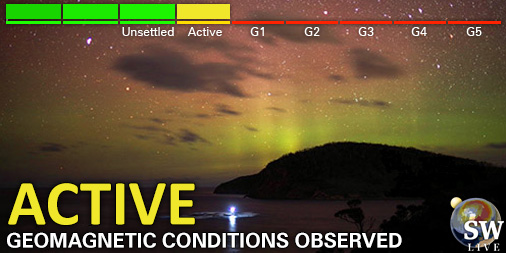Het archief bekijken van zaterdag 25 oktober 2014
Selecteer het gewenste archief onderdeel
X1.0 solar flare from sunspot region 2192
Sunspot region 2192 did it again! Less than 24 hours after the major X3.19 solar flare from yesterday, it now produced a major X1.04 (R3-strong radio blackout) solar flare at 17:08 UTC. This was already it's fourth X-class solar flare but again it looks like it did not launch a coronal mass ejection.
Evolution of sunspot region 2192
Solar activity has been low since yesterday's X3.19 solar flare which did not release a coronal mass ejection. The strongest solar flares today have been two C9 class solar flares. Sunspot region 2192 decayed slightly but it's largest delta spot near the large trailer spot continued to strengthen. We will take a look at it in this article. Sunspot region 2192 remains however one of the largest sunspot regions in modern times and it is so large that it can be seen by the naked eye. Our header image comes from Simon Toogood who captured this image of the Sun that shows large sunspot region 2192 in all it's glory. The setting Sun was dimmed so much by dense haze over Australia that he could capture this cracking shot. Do note that you should never look at the sun without proper eye-protection or through unfiltered optics. Even when dimmed, the Sun can still cause serious eye damage when directly viewed trough a lens.
Laatste nieuws
Laatste forumberichten
Steun Poollicht.be!
Om ook bereikbaar te blijven bij grote poollichtkansen hebben we een zware server nodig die alle bezoekers aankan. Doneer en steun dit project zodat we online blijven en je geen enkele poollichtkans mist!

Laatste alerts
03:15 UTC - Geomagnetische activiteit
Actieve geomagnetische condities (Kp4) Drempel bereikt: 02:59 UTC
dinsdag 29 april 2025
11:15 UTC - Zonnevlam
Matige M1.65 zonnevlam van zonnevlekkengebied 4078
11:00 UTC - Radio blackout
Kleine R1 radio blackout gedetecteerd (≥M1 - momenteel: M1.63)
10:21 UTC - Zonnevlam
Matige M1.31 zonnevlam van zonnevlekkengebied 4078
10:03 UTC - Radio blackout
Kleine R1 radio blackout gedetecteerd (≥M1 - momenteel: M1.1)
Ruimteweer feitjes
| Laatste X-klasse uitbarsting | 28/03/2025 | X1.1 |
| Laatste M-klasse uitbarsting | 29/04/2025 | M1.6 |
| Laatste geomagnetische storm | 21/04/2025 | Kp5+ (G1) |
| Zonnevlekkenloze dagen | |
|---|---|
| Laatste zonnevlekkenloze dag | 08/06/2022 |
| Maandelijks gemiddeld zonnevlekkengetal | |
|---|---|
| maart 2025 | 134.2 -20.4 |
| april 2025 | 126.5 -7.7 |
| Afgelopen 30 dagen | 127.3 +0.3 |





